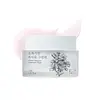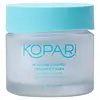What's inside
What's inside
 Key Ingredients
Key Ingredients

 Benefits
Benefits

 Concerns
Concerns

 Ingredients Side-by-side
Ingredients Side-by-side

Water
Skin ConditioningButylene Glycol
HumectantPhenyl Trimethicone
Skin ConditioningGlycerin
Humectant1,2-Hexanediol
Skin ConditioningAmmonium Acryloyldimethyltaurate/Vp Copolymer
Glucose
HumectantCarbomer
Emulsion StabilisingChlorella Vulgaris Extract
Skin ConditioningTromethamine
BufferingCaprylyl Glycol
EmollientFructose
HumectantFructooligosaccharides
HumectantSodium Hyaluronate
HumectantDipotassium Glycyrrhizate
HumectantOryza Sativa Extract
AbsorbentDisodium EDTA
Citrus Aurantium Bergamia Fruit Oil
MaskingEthylhexylglycerin
Skin ConditioningLavandula Angustifolia Oil
MaskingCyanocobalamin
Skin ConditioningPrunus Persica Flower Extract
MoisturisingLilium Candidum Flower Extract
Skin ConditioningPrunus Persica Fruit Extract
AbrasiveMethylpropanediol
SolventPaeonia Albiflora Root Extract
Skin ConditioningMagnolia Liliflora Flower Extract
Skin ConditioningBifida Ferment Extract
HumectantWater, Butylene Glycol, Phenyl Trimethicone, Glycerin, 1,2-Hexanediol, Ammonium Acryloyldimethyltaurate/Vp Copolymer, Glucose, Carbomer, Chlorella Vulgaris Extract, Tromethamine, Caprylyl Glycol, Fructose, Fructooligosaccharides, Sodium Hyaluronate, Dipotassium Glycyrrhizate, Oryza Sativa Extract, Disodium EDTA, Citrus Aurantium Bergamia Fruit Oil, Ethylhexylglycerin, Lavandula Angustifolia Oil, Cyanocobalamin, Prunus Persica Flower Extract, Lilium Candidum Flower Extract, Prunus Persica Fruit Extract, Methylpropanediol, Paeonia Albiflora Root Extract, Magnolia Liliflora Flower Extract, Bifida Ferment Extract
Water
Skin ConditioningGlycerin
HumectantCaprylic/Capric Triglyceride
MaskingOctyldodecanol
EmollientDicaprylyl Ether
Emollient2,3-Butanediol
HumectantGlyceryl Stearate Citrate
EmollientCetearyl Alcohol
Emollient1,2-Hexanediol
Skin ConditioningSqualane
EmollientButyrospermum Parkii Butter
Skin ConditioningBehenyl Alcohol
EmollientHydrogenated Lecithin
EmulsifyingPolyglyceryl-10 Stearate
Skin ConditioningSodium Polyacrylate
AbsorbentBehenic Acid
CleansingStearic Acid
CleansingStearyl Alcohol
EmollientCocos Nucifera Fruit Extract
EmollientMyristic Acid
CleansingSimmondsia Chinensis Seed Oil
EmollientCeramide NP
Skin ConditioningTriethylhexanoin
MaskingPhospholipids
Skin ConditioningEthylhexylglycerin
Skin ConditioningHydrogenated Polydecene
EmollientAdansonia Digitata Seed Oil
EmollientCitrullus Lanatus Seed Oil
EmollientGlyceryl Undecylenate
EmollientGlyceryl Caprylate
EmollientCholesterol
EmollientPropanediol
SolventPhytosphingosine
Skin ConditioningTocopherol
AntioxidantAloe Barbadensis Leaf Juice
Skin ConditioningAdansonia Digitata Fruit Extract
EmollientXanthan Gum
EmulsifyingSodium Hyaluronate
HumectantWater, Glycerin, Caprylic/Capric Triglyceride, Octyldodecanol, Dicaprylyl Ether, 2,3-Butanediol, Glyceryl Stearate Citrate, Cetearyl Alcohol, 1,2-Hexanediol, Squalane, Butyrospermum Parkii Butter, Behenyl Alcohol, Hydrogenated Lecithin, Polyglyceryl-10 Stearate, Sodium Polyacrylate, Behenic Acid, Stearic Acid, Stearyl Alcohol, Cocos Nucifera Fruit Extract, Myristic Acid, Simmondsia Chinensis Seed Oil, Ceramide NP, Triethylhexanoin, Phospholipids, Ethylhexylglycerin, Hydrogenated Polydecene, Adansonia Digitata Seed Oil, Citrullus Lanatus Seed Oil, Glyceryl Undecylenate, Glyceryl Caprylate, Cholesterol, Propanediol, Phytosphingosine, Tocopherol, Aloe Barbadensis Leaf Juice, Adansonia Digitata Fruit Extract, Xanthan Gum, Sodium Hyaluronate
Ingredients Explained
These ingredients are found in both products.
Ingredients higher up in an ingredient list are typically present in a larger amount.
1,2-Hexanediol is a synthetic liquid and another multi-functional powerhouse.
It is a:
- Humectant, drawing moisture into the skin
- Emollient, helping to soften skin
- Solvent, dispersing and stabilizing formulas
- Preservative booster, enhancing the antimicrobial activity of other preservatives
Ethylhexylglycerin (we can't pronounce this either) is commonly used as a preservative and skin softener. It is derived from glyceryl.
You might see Ethylhexylglycerin often paired with other preservatives such as phenoxyethanol. Ethylhexylglycerin has been found to increase the effectiveness of these other preservatives.
Glycerin is already naturally found in your skin. It helps moisturize and protect your skin.
A study from 2016 found glycerin to be more effective as a humectant than AHAs and hyaluronic acid.
As a humectant, it helps the skin stay hydrated by pulling moisture to your skin. The low molecular weight of glycerin allows it to pull moisture into the deeper layers of your skin.
Hydrated skin improves your skin barrier; Your skin barrier helps protect against irritants and bacteria.
Glycerin has also been found to have antimicrobial and antiviral properties. Due to these properties, glycerin is often used in wound and burn treatments.
In cosmetics, glycerin is usually derived from plants such as soybean or palm. However, it can also be sourced from animals, such as tallow or animal fat.
This ingredient is organic, colorless, odorless, and non-toxic.
Glycerin is the name for this ingredient in American English. British English uses Glycerol/Glycerine.
Learn more about GlycerinSodium Hyaluronate is hyaluronic acid's salt form. It is commonly derived from the sodium salt of hyaluronic acid.
Like hyaluronic acid, it is great at holding water and acts as a humectant. This makes it a great skin hydrating ingredient.
Sodium Hyaluronate is naturally occurring in our bodies and is mostly found in eye fluid and joints.
These are some other common types of Hyaluronic Acid:
Learn more about Sodium HyaluronateWater. It's the most common cosmetic ingredient of all. You'll usually see it at the top of ingredient lists, meaning that it makes up the largest part of the product.
So why is it so popular? Water most often acts as a solvent - this means that it helps dissolve other ingredients into the formulation.
You'll also recognize water as that liquid we all need to stay alive. If you see this, drink a glass of water. Stay hydrated!
Learn more about Water